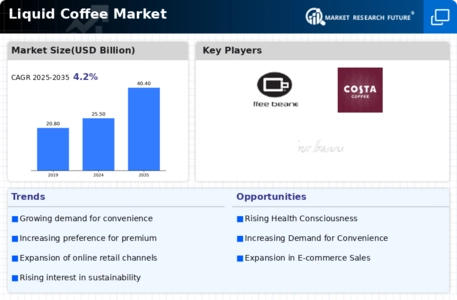Leading market players are investing heavily in research and development in order to expand their product lines, which will help the Liquid Coffee market, grow even more. Market participants are also undertaking a variety of strategic activities to expand their global footprint, with important market developments including new product launches, contractual agreements, mergers and acquisitions, higher investments, and collaboration with other organizations. To expand and survive in a more competitive and rising market climate, Liquid Coffee industry must offer cost-effective items.
Manufacturing locally to minimize operational costs is one of the key business tactics used by manufacturers in the global Liquid Coffee industry to benefit clients and increase the market sector. In recent years, the Liquid Coffee industry has offered some of the most significant advantages to medicine. Major players in the Liquid Coffee market, including Café Amazon, Café du Monde, Caffè Nero, Coffee Beanery, Costa Coffee, Dunkin'Donuts LLC, Four Barrel Coffee, Gloria Jean’s Coffees, McCafé USA, and Starbucks Corporation, and others, are attempting to increase market demand by investing in research and development operations.
Quick-service restaurant franchisor Dunkin' Brands Group Inc. (Dunkin) is in this business. It operates and franchises eateries and ice cream shops under the names of its subsidiaries, Dunkin' Donuts and Baskin-Robbins. Under the Dunkin' doughnuts brand, the firm sells a variety of doughnuts, bagels, muffins, breakfast sandwiches, and hot and cold coffee. Under the Baskin-Robbins brand, it sells a variety of ice creams and frozen drinks. It does its business through a number of distribution centres both domestically and abroad. Through joint ventures and master franchise agreements, Dunkin' franchises its restaurants.
Starbucks Corp. (Starbucks) is a retailer of speciality coffee. Speciality coffee is roasted, marketed, and sold in stores. The business sells a variety of coffee blends, artisan beverages, goods, and food products through its outlets. Additionally, Starbucks provides ready-made drinks, pastries, whole bean and ground coffee, as well as other libations. Teavana, Starbucks Reserve, Princi, and Ethos are some of its brands. Through its owned and licenced stores, the corporation has a presence in Asia-Pacific, the Middle East, Africa, Europe, and the Americas.
In China in addition to Nevada, Pennsylvania, Tennessee, and Washington in the United States, it runs roasting, production, storage, and distribution operations. Seattle, Washington, in the US, is home to Starbucks.














